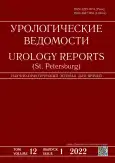Malacoplakia of the urinary bladder. Clinical case report
- Authors: Barysheva O.Y.1,2, Simanov R.N.1,2, Bukalev A.V.2
-
Affiliations:
- Petrozavodsk State University
- Republican Hospital named after V.A. Baranov
- Issue: Vol 12, No 1 (2022)
- Pages: 91-98
- Section: Сlinical observations
- URL: https://journals.rcsi.science/uroved/article/view/96740
- DOI: https://doi.org/10.17816/uroved96740
- ID: 96740
Cite item
Abstract
A clinical case of bladder malacoplakia in a 33-year-old woman, clinically manifested by dysuria and gross hematuria, is presented. Malacoplakia is a rare tumor-like granulomatous-inflammatory disease with a predominant lesion of the bladder mucosa. The literature describes extravesical forms of malacoplakia with involvement of the ureters, renal pelvis and calyces, prostate, testicles and their appendages, intestines and other organs. In women, the disease occurs 4 times more often than in men. The reasons for the development of malacoplakia are not fully understood. The main importance in its pathogenesis is attached to the infectious factor and immunosuppression. Diagnosis is based on histological examination of bladder biopsy specimens and the detection of Hansemann cells and Michaelis – Gutman bodies. Treatment of patients with malacoplakia consists of resection of the affected areas of the bladder and antibiotic therapy.
Full Text
##article.viewOnOriginalSite##About the authors
Olga Yu. Barysheva
Petrozavodsk State University; Republican Hospital named after V.A. Baranov
Email: hosptherapy@mail.ru
ORCID iD: 0000-0002-2133-4849
SPIN-code: 4896-5434
Dr. Sci. (Med.), Professor of the Department of Hospital Therapy, Head of the Nephrological Unit
Russian Federation, 3, Pirogova st., Petrozavodsk, Republic of Karelia, 185019; PetrozavodskRuslan N. Simanov
Petrozavodsk State University; Republican Hospital named after V.A. Baranov
Email: Ruslansimanov@yandex.ru
ORCID iD: 0000-0003-1246-7233
SPIN-code: 3747-8245
Postgraduate Student, Urologist
Russian Federation, 3, Pirogova st., Petrozavodsk, Republic of Karelia, 185019; PetrozavodskAndrej V. Bukalev
Republican Hospital named after V.A. Baranov
Author for correspondence.
Email: Dr.max-andy@yandex.ru
ORCID iD: 0000-0003-2080-3057
SPIN-code: 1230-2277
MD, Cand. Sci. (Med.), Pathologist
Russian Federation, 3, Pirogova st., Petrozavodsk, Republic of Karelia, 185019References
- Michaelis I, Gutmann C. Uber Einschlusse in Blasentumoren. Z Klin Med. 1902;(47):208–215. (In German.)
- Lelyavin KB, Zaitseva LV, Raevskaya LYu, Lelyavina AK. Malakoplakia of the bladder mimicking malignancy: report of cases and review of the literature. Medical and pharmaceutical journal “Pulse”. 2021;23(7):121–128. (In Russ.) doi: 10.26787/nydha-2686-6838-2021-23-7-121-128
- Yousef GM, Naghibi B. Malakoplakia outside the urinary tract. Arch Pathol Lab Med. 2007;131(2):297–300. doi: 10.5858/2007-131-297-MOTUT
- Minor L, Lindgren BW. Malacoplakia of the bladder in a 16-year-old girl. J Urol. 2003;170(2):568–589. doi: 10.1097/01.ju.0000071475.79104.98
- Wielenberg AJ, Demos TC, Rangachari B, Turk T. Malacoplakia presenting as a solitary renal mass. AJR Am J Roentgenol. 2004;183(6):1703–1705. doi: 10.2214/ajr.183.6.01831703
- Sloane BB, Figueroa TE, Ferguson D, Moon TD. Malacoplakia of the urethra. J Urol. 1988;139(6):1300–1301. doi: 10.1016/s0022-5347(17)42900-4
- Scott EV, Scott WF Jr. A fatal case of malakoplakia of the urinary tract. J Urol. 1958;79(1):52–56. doi: 10.1016/s0022-5347(17)66233-5
- Volk E, Parker JC Jr, Tepper S. Cerebral malakoplakia associated with neonatal herpes virus infection. Ann Clin Lab Sci. 1992;22(5):300–306.
- Gustavo LC, Robert ME, Lamps LW, et al. Isolated gastric malakoplakia: a case report and review of the literature. Arch Pathol Lab Med. 2004;128(11): e153–156. doi: 10.5858/2004-128-e153-IGMACR
- Graves AL, Texler M, Manning L, Kulkarni H. Successful treatment of renal allograft and bladder malakoplakia with minimization of immunosuppression and prolonged antibiotic therapy. Nephrology (Carlton). 2014;19(S1):18–21. doi: 10.1111/nep.12194
- Hyun KH, Shin HD, Kim DH. Malakoplakia in a healthy young female patient. Korean J Intern Med. 2013;28(4):475–480. doi: 10.3904/kjim.2013.28.4.475
- Lou TY, Teplitz C. Malakoplakia: pathogenesis and ultrastructural morphogenesis. A problem of altered macrophage (phagolysosomal) response. Hum Pathol. 1974;5(2):191–207. doi: 10.1016/s0046-8177(74)80066-3
- Govender D, Essa AS. Malakoplakia and tuberculosis. Pathology. 1999;31(3):280–283. doi: 10.1080/003130299105160
- Puerto IM, Mojarrieta JC, Martinez IB, Navarro S. Renal malakoplakia as a pseudotumoral lesion in a renal transplant patient: a case report. Int J Urol. 2007;14(7):655–657. doi: 10.1111/j.1442-2042.2007.01804.x
- Leão CA, Duarte MI, Gamba C, et al. Malakoplakia after renal transplantation in the current era of immunosuppressive therapy: case report and literature review. Transpl Infect Dis. 2012;14(6): E137–E141. doi: 10.1111/tid.12012
- Darvishian F, Teichberg S, Meyersfield S, Urmacher CD. Concurrent malakoplakia and papillary urothelial carcinoma of the urinary bladder. Ann Clin Lab Sci. 2001;31(2):147–150.
- Purnell SD, Davis B, Burch-Smith R, Coleman P. Renal malakoplakia mimicking a malignant renal carcinoma: a patient case with literature review. BMJ Case Rep. 2015;2015: bcr2014208652. doi: 10.1136/bcr-2014-208652
- Esparza AR, McKay DB, Cronan JJ, Chazan JA. Renal parenchymal malakoplakia. Histologic spectrum and its relationship to megalocytic interstitial nephritis and xanthogranulomatous pyelonephritis. Am J Surg Pathol. 1989;13(3):225–236. doi: 10.1097/00000478-198903000-00008
- Samsonov VA. Opukholi mochevogo puzyrya. Patologicheskaya anatomiya i gistologicheskaya diagnostika. Moscow: Meditsina, 1978. 170 p. (In Russ.)
- Dong H, Dawes S, Philip J, et al. Malakoplakia of the Urogenital Tract. Urol Case Rep. 2014;3(1):6–8. doi: 10.1016/j.eucr.2014.10.002
- Cięszczyk K, Puderecki M, Wronecki L, et al. Malakoplakia of the urinary system. Folia Med Cracov. 2019;59(2): 67–74.
- Kayembe B, Sohawon S, Duttmann R, et al. Coexistence of renal malakoplakia and myelodysplastic syndrome. Intern Med J. 2012;42(4): e27–e29. doi: 10.1111/j.1445-5994.2011.02692.x
Supplementary files











